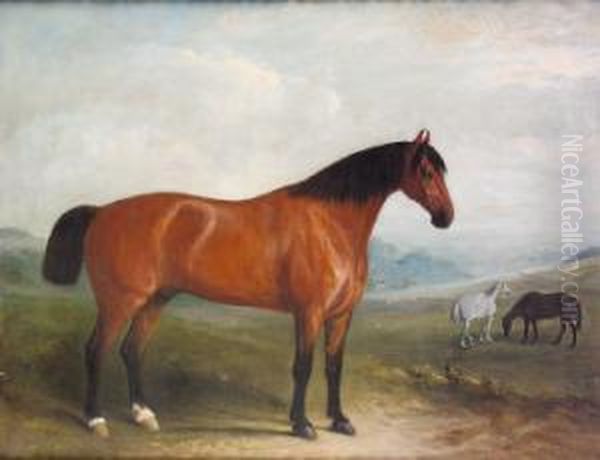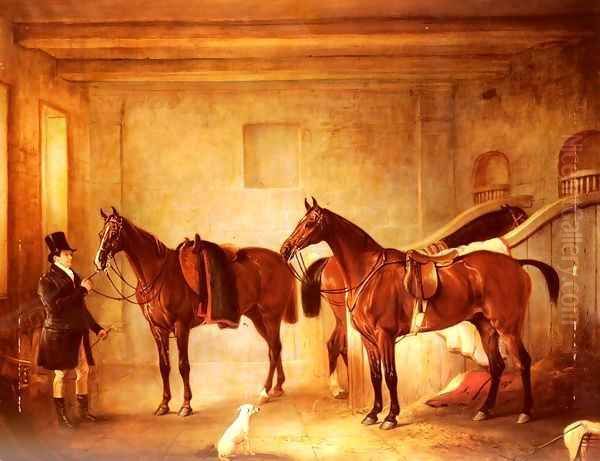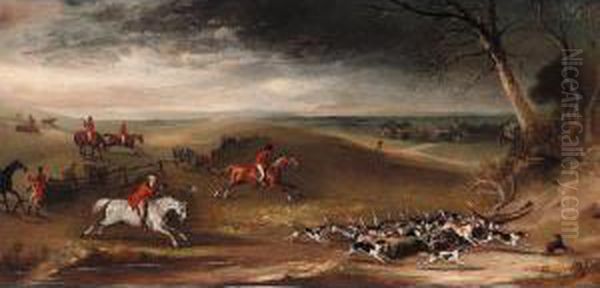John Ferneley, Jr. stands as a significant figure in the rich tapestry of British sporting art, a genre that flourished with particular vibrancy in the 19th century. Born into an artistic lineage, he not only inherited a passion for depicting the dynamic world of equestrian pursuits but also carved out his own distinct identity within this specialized field. His life and work offer a fascinating window into the tastes, pastimes, and social fabric of Victorian England, particularly its landed gentry and military circles.
Early Life and Paternal Influence
John Ferneley, Jr. was born on May 18, 1815, in Melton Mowbray, Leicestershire. This location was no mere accident of birth; Melton Mowbray was the undisputed capital of fox-hunting in England, a crucible where sporting life and art converged. His father, John E. Ferneley, Sr. (1782–1860), was one of the preeminent sporting artists of his generation, renowned for his masterful depictions of horses, hounds, and hunt scenes. The elder Ferneley had established a thriving practice in Melton Mowbray, attracting patronage from the highest echelons of society.
Growing up in such an environment, John Jr. was immersed in the world of sporting art from his earliest years. His father's studio would have been his first school, a place filled with the sights and sounds of artistic creation, the smell of oil paints and turpentine, and the constant discussion of equine anatomy, composition, and the nuances of capturing the thrill of the chase. It was inevitable that the young Ferneley would absorb these influences, developing an early appreciation for the technical skill and keen observation required by the genre.
Unlike his father, who had been apprenticed to the great sporting painter Benjamin Marshall (1768–1835) in London after his talent was recognized by John Manners, 5th Duke of Rutland, John Jr.'s primary tutelage came directly from his father. This close artistic relationship shaped his formative years, providing him with a strong foundation in the traditions and techniques of sporting painting. He learned to observe horses with a discerning eye, to understand their movement and musculature, and to translate these observations onto canvas with accuracy and vitality.
Forging an Independent Path

While the influence of John E. Ferneley, Sr. was profound and undeniable, John Ferneley, Jr. was determined to establish himself as an artist in his own right. He began his professional career working for a period in Manchester and later in York, before eventually settling in Leeds. These moves suggest a desire to cultivate his own network of patrons and to develop a practice independent of his father's immediate sphere of influence in Melton Mowbray.
York, in particular, proved to be a fruitful location. The city and its surrounding county had a strong tradition of horse racing and hunting, and it was home to a significant military presence. Ferneley, Jr. found favor among the cavalry officers stationed there, who commissioned portraits of their prized chargers and depictions of military maneuvers. This focus on military subjects became one of the distinguishing features of his oeuvre, setting him somewhat apart from his father, whose work was more exclusively centered on the hunt and racing.
Despite developing his own style, the close association with his father sometimes led to confusion in attribution. Both artists often signed their works "J. Ferneley," though John Jr. would frequently add "Jr." or "York" (especially during his time there) to differentiate his paintings. Their collaborative efforts on certain commissions, though not extensively documented, also highlight the ongoing artistic dialogue between father and son.
Artistic Style and Thematic Focus
John Ferneley, Jr.'s artistic style is characterized by its meticulous attention to detail, vibrant yet controlled palette, and a keen sense of dynamism. He inherited his father's ability to render equine anatomy with precision, but his work often displays a slightly more polished finish and a compositional approach that reflected the evolving tastes of the mid-Victorian era. His paintings are less rugged than some of his father's earlier, more robust canvases, showing an adaptation to the prevailing aesthetic.
His primary thematic concerns remained rooted in the world of sporting and animal painting. Horses were, naturally, central to his art – whether they were hunters, racehorses, carriage horses, or military chargers. He captured their individual characteristics, their spirit, and their graceful power. Hunting scenes, a staple of the Ferneley family tradition, continued to feature prominently, depicting the excitement of the chase, the colorful array of riders and hounds, and the picturesque English countryside.

Beyond the hunt, Ferneley, Jr. also excelled in portraying other aspects of rural and aristocratic life. Portraits of gentlemen with their favorite hunters or gundogs, depictions of coaching scenes, and, as mentioned, military subjects, all found a place in his repertoire. His ability to capture not just the animals but also the human figures, their attire, and the surrounding landscapes with accuracy contributed to the appeal of his work. He understood the importance of narrative and often imbued his scenes with a sense of occasion or a specific moment in time.
Notable Works
Several paintings stand out as representative of John Ferneley, Jr.'s skill and thematic interests. Among these, "An Egyptian Pony" (1856) is a fine example of his animal portraiture. The work showcases his ability to capture the unique characteristics of a specific breed, rendered with a delicate touch and an appreciation for the animal's elegant form. The attention to the pony's coat, its intelligent eye, and its poised stance are hallmarks of his careful observation.
Another significant piece is "A Meet of the York and Ainsty with George Lloyd, M.F.H. and W. Naylor, Huntsman" (1856). This painting is a classic example of a hunt portrait, a complex composition featuring numerous figures, horses, and hounds, all set within a specific landscape. Such works were highly prized by hunt members, serving as both a record of a particular event and a celebration of the communal spirit of the sport. Ferneley, Jr.'s skill in organizing such a busy scene, while maintaining clarity and individualizing the key participants, is evident.
While his father, John E. Ferneley, Sr., is famously associated with "The Scurry of the Sandor Hunt in Leicestershire" (often referred to as the Quorn Hunt Scurry), a series of aquatints after his paintings, John Jr. is documented as having participated in the creation of some of these colored prints. This involvement underscores the family's collaborative spirit and John Jr.'s early immersion in the production and dissemination of sporting art. It is also noted that John Jr. himself created a series of paintings titled "The Scurry of the Sandor Hunt in Leicestershire," indicating his own engagement with this iconic subject matter, perhaps offering a fresh perspective or catering to a new generation of patrons.
Other works, such as "Verity," demonstrate his consistent output of high-quality animal portraits. Paintings like "Oxen and Drover" and "Mr. Green's Bay Mare," though sometimes attributed broadly within the Ferneley family, showcase the type of subject matter – agricultural scenes and individual horse portraits – that were part of his artistic vocabulary.
The Ferneley Legacy: Father and Son

The relationship between John Ferneley, Jr. and his father, John E. Ferneley, Sr., is central to understanding his career. The elder Ferneley was a towering figure in sporting art, a contemporary of other notable artists in the field such as Henry Alken Sr. (1785–1851) and his son Henry Gordon Alken (1810–1894), who were prolific in depicting coaching, racing, and hunting scenes, often with a lively, almost caricatured energy. John E. Ferneley, Sr.'s style, influenced by Benjamin Marshall, was characterized by anatomical accuracy and a direct, unfussy portrayal of his subjects.
John Jr. built upon this foundation. While his father's ledger books meticulously record commissions and patrons, providing invaluable insight into his career, John Jr.'s own practice, though perhaps less extensively documented in surviving personal records, clearly thrived. He successfully navigated the art market of his time, adapting his style to meet the demands of his patrons while retaining the core strengths of the Ferneley tradition.
The distinction in their signatures – "J. Ferneley" for the father, and often "John Ferneley, Jr." or "J. Ferneley, York" for the son – was a practical measure to avoid confusion, but it also symbolized John Jr.'s assertion of his own artistic identity. His decision to work in different geographical locations further underscores this.
Contemporaries and the Wider Artistic Context
John Ferneley, Jr. worked during a period of great activity in British art. While he specialized in sporting subjects, the broader art world was experiencing diverse movements and trends. The Pre-Raphaelite Brotherhood, with figures like John Everett Millais (1829–1896) and Dante Gabriel Rossetti (1828–1882), was challenging academic conventions with their detailed realism and literary themes. Landscape painting, following the towering achievements of J.M.W. Turner (1775–1851) and John Constable (1776–1837), continued to evolve.
Within the realm of animal and sporting art, Ferneley, Jr. had numerous contemporaries. Sir Edwin Landseer (1802–1873) was perhaps the most famous animal painter of the Victorian era, beloved by Queen Victoria herself, known for his sentimental and anthropomorphic depictions of animals, particularly stags and dogs, in works like "The Monarch of the Glen." Richard Ansdell (1815–1885) was another prominent animal painter, often collaborating with artists like Thomas Creswick on landscapes, and known for his dramatic scenes of animal combat or rural life.
Sir Francis Grant (1803–1878), who later became President of the Royal Academy, started his career as a painter of sporting scenes and portraits, and there is evidence that Grant occasionally assisted John Ferneley, Jr. with figures in his compositions. This collaboration indicates a collegial atmosphere among some sporting artists. Abraham Cooper (1787–1868) was another established figure, known for his battle scenes and depictions of horses and dogs, often with a strong narrative element.
The work of earlier masters like George Stubbs (1724–1806), with his unparalleled anatomical studies of horses, and Sawrey Gilpin (1733–1807), known for his romantic and spirited animal paintings, had laid the groundwork for the genre. James Ward (1769–1859), a pupil of his brother William Ward who engraved many of George Morland's works, became a powerful animal painter in his own right, known for his large-scale, dramatic compositions. Heywood Hardy (1842-1933), though slightly later, continued the tradition of sporting and animal painting into the early 20th century.
John Ferneley, Jr.'s work, therefore, existed within a vibrant and competitive field. His adherence to a more traditional, though refined, style of sporting art provided a consistent appeal to patrons who valued accurate representation and the celebration of their equestrian lifestyle, perhaps as a counterpoint to the more overtly sentimental or romantic trends in animal painting.
The Sporting Art Tradition and Its Patrons
Sporting art in 19th-century Britain was more than just a niche genre; it was a reflection of a way of life. For the landed gentry and aristocracy, activities like fox-hunting, horse racing, and shooting were central to their social identity and leisure. Commissioning paintings of favorite horses, memorable hunts, or champion racers was a way to commemorate these passions, display wealth and status, and adorn their country houses.
John Ferneley, Jr., like his father, catered to this clientele. His patrons were typically country squires, Masters of Fox Hounds (M.F.H.), military officers, and enthusiasts of field sports. These individuals sought artists who could not only paint a likeness but also understand the intricacies of the sport, the points of a good horse, and the etiquette of the field. The Ferneleys, with their deep immersion in the hunting world of Leicestershire and beyond, were perfectly positioned to meet these requirements.
The demand for such art also extended to prints and engravings, which allowed for wider dissemination of popular images. The involvement of both Ferneleys in the production of prints after their paintings indicates an awareness of this broader market.
Anecdotes and Personal Insights
While detailed personal anecdotes about John Ferneley, Jr. are less abundant than those surrounding his more extensively documented father, certain aspects of his life offer glimpses into his character and career. His move to York around 1839 was a strategic one, likely influenced by the strong military and hunting communities there, which provided a ready source of patronage. This demonstrates a degree of entrepreneurial spirit and an understanding of where his skills would be most valued.
The fact that his father was initially a wheelwright, whose artistic talent was discovered and nurtured by a noble patron (the Duke of Rutland), is a well-known story in the Ferneley family history. This background, of talent overcoming modest origins, likely instilled a strong work ethic in the family. John Jr., benefiting from his father's established reputation, nonetheless had to prove his own merit, which he did by developing a distinct, albeit related, artistic voice.
His style, while rooted in the 18th-century traditions of sporting art, evolved to incorporate a more polished, typically 19th-century aesthetic. This adaptation suggests an artist attuned to the tastes of his time, capable of evolving while retaining the core strengths of his training.
Auction History and Collections
Works by John Ferneley, Jr. continue to appear on the art market, testament to their enduring appeal among collectors of sporting art. His paintings have been handled by major auction houses such as Sotheby's, Christie's, Phillips, and Bonhams. Prices can vary significantly based on size, subject matter, condition, and provenance, with major hunt scenes or fine equestrian portraits commanding substantial sums.
While many of his works reside in private collections, reflecting their original commissioning by individuals, examples of the Ferneley family's art (both Sr. and Jr.) can be found in public institutions. The Tate Gallery in London and the National Museum of Racing and Hall of Fame in Saratoga Springs, New York, hold works by John E. Ferneley, Sr., and it is likely that John Jr.'s paintings are also represented in similar specialized collections focusing on British art or sporting history, such as Calke Abbey or The Brooke Robinson Museum. The very nature of sporting art, often commissioned for specific family homes, means that a significant portion remains in the hands of descendants of the original patrons.
Later Life and Legacy
John Ferneley, Jr. passed away in Leeds on June 10, 1862, at the relatively young age of 47. His career, though shorter than his father's, was productive and successful. He made a significant contribution to the field of sporting art, upholding the high standards set by his father while also developing his own nuanced style. His paintings of military subjects, in particular, added a distinct dimension to the Ferneley family's artistic output.
His brother, Claude Lorraine Ferneley (1822–1891), also became an artist, further extending the family's artistic dynasty, though he is perhaps less widely known than his father or elder brother. The Ferneley name remains synonymous with the golden age of British sporting painting.
Academically, John Ferneley, Jr. is recognized for his technical proficiency, his faithful depiction of equestrian subjects, and his role in chronicling a specific aspect of 19th-century British culture. His works are valued not only for their aesthetic qualities but also as historical documents, offering insights into the pastimes, attire, and social customs of the era. He successfully carried the torch of a distinguished artistic lineage, ensuring that the Ferneley contribution to sporting art remained vibrant and relevant throughout his lifetime.
Conclusion: An Enduring Contribution to British Art
John Ferneley, Jr. occupies an important place in the history of British sporting art. As the son of one of the genre's leading practitioners, he inherited a rich artistic legacy and a deep understanding of his subject matter. He skillfully navigated the challenges of following a famous father, establishing his own reputation through hard work, talent, and an ability to connect with the patrons of his day.
His paintings, characterized by their detailed realism, lively compositions, and sensitive portrayal of animals, particularly horses, continue to be admired. They capture the spirit and elegance of the equestrian world, from the thrill of the hunt to the formal precision of military display. John Ferneley, Jr.'s work stands as a testament to a unique artistic tradition and offers a vivid portrayal of a bygone era in British social and sporting history, securing his position as a respected and accomplished artist within this specialized and enduringly popular genre.